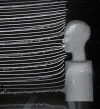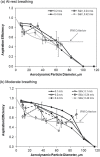Computational fluid dynamics investigation of human aspiration in low-velocity air: orientation effects on mouth-breathing simulations
- PMID: 23316076
- PMCID: PMC3916737
- DOI: 10.1093/annhyg/mes108
Computational fluid dynamics investigation of human aspiration in low-velocity air: orientation effects on mouth-breathing simulations
Abstract
Computational fluid dynamics was used to investigate particle aspiration efficiency in low-moving air typical of occupational settings (0.1-0.4 m s(-1)). Fluid flow surrounding an inhaling humanoid form and particle trajectories traveling into the mouth were simulated for seven discrete orientations relative to the oncoming wind (0°, 15°, 30°, 60°, 90°, 135° and 180°). Three continuous inhalation velocities (1.81, 4.33, and 12.11 m s(-1)), representing the mean inhalation velocity associated with sinusoidal at-rest, moderate, and heavy breathing (7.5, 20.8, and 50.3 l min(-1), respectively) were simulated. These simulations identified a decrease in aspiration efficiency below the inhalable particulate mass (IPM) criterion of 0.5 for large particles, with no aspiration of particles 100 µm and larger for at-rest breathing and no aspiration of particles 116 µm for moderate breathing, over all freestream velocities and orientations relative to the wind. For particles smaller than 100 µm, orientation-averaged aspiration efficiency exceeded the IPM criterion, with increased aspiration efficiency as freestream velocity decreased. Variability in aspiration efficiencies between velocities was low for small (<22 µm) particles, but increased with increasing particle size over the range of conditions studied. Orientation-averaged simulation estimates of aspiration efficiency agree with the linear form of the proposed linear low-velocity inhalable convention through 100 µm, based on laboratory studies using human mannequins.
Keywords: CFD inhalability; aspiration efficiency; computational fluid dynamics; continuous inhalation; inhalable particulate mass; mouth breathing; orientation averaged; particle aspiration; particle transport; ultralow velocity.
Figures











Similar articles
-
Computational fluid dynamics investigation of human aspiration in low velocity air: orientation effects on nose-breathing simulations.Ann Occup Hyg. 2014 Jun;58(5):625-45. doi: 10.1093/annhyg/meu018. Epub 2014 Mar 24. Ann Occup Hyg. 2014. PMID: 24665111 Free PMC article.
-
Contribution of facial feature dimensions and velocity parameters on particle inhalability.Ann Occup Hyg. 2010 Aug;54(6):710-25. doi: 10.1093/annhyg/meq040. Epub 2010 May 10. Ann Occup Hyg. 2010. PMID: 20457783 Free PMC article.
-
An empirical model of human aspiration in low-velocity air using CFD investigations.J Occup Environ Hyg. 2015;12(4):245-55. doi: 10.1080/15459624.2014.970273. J Occup Environ Hyg. 2015. PMID: 25438035 Free PMC article.
-
Perspectives on aerosol inhalability: concepts and applications.Crit Rev Toxicol. 2025 Feb;55(2):227-247. doi: 10.1080/10408444.2025.2458276. Epub 2025 Feb 27. Crit Rev Toxicol. 2025. PMID: 40013986 Review.
-
Potential and constraints for the application of CFD combined with Lagrangian particle tracking to dry powder inhalers.Eur J Pharm Sci. 2019 Feb 1;128:299-324. doi: 10.1016/j.ejps.2018.12.008. Epub 2018 Dec 14. Eur J Pharm Sci. 2019. PMID: 30553814 Review.
Cited by
-
Did You Just Cough? Visualization of Vapor Diffusion in an Office Using Computational Fluid Dynamics Analysis.Int J Environ Res Public Health. 2022 Aug 11;19(16):9928. doi: 10.3390/ijerph19169928. Int J Environ Res Public Health. 2022. PMID: 36011558 Free PMC article.
-
Influence of secondary aspiration on human aspiration efficiency.J Aerosol Sci. 2014 Sep;75:65-80. doi: 10.1016/j.jaerosci.2014.04.008. J Aerosol Sci. 2014. PMID: 26778849 Free PMC article.
-
Sampling efficiency of modified 37-mm sampling cassettes using computational fluid dynamics.J Occup Environ Hyg. 2016;13(2):148-58. doi: 10.1080/15459624.2015.1091961. J Occup Environ Hyg. 2016. PMID: 26513395 Free PMC article.
-
A Rapidly Deployable Test Suite for Respiratory Protective Devices in the COVID-19 Pandemic.Appl Biosaf. 2020 Sep;25(3):161-168. doi: 10.1177/1535676020947284. Epub 2020 Oct 8. Appl Biosaf. 2020. PMID: 33281505 Free PMC article.
-
Computational fluid dynamics investigation of human aspiration in low velocity air: orientation effects on nose-breathing simulations.Ann Occup Hyg. 2014 Jun;58(5):625-45. doi: 10.1093/annhyg/meu018. Epub 2014 Mar 24. Ann Occup Hyg. 2014. PMID: 24665111 Free PMC article.
References
-
- ACGIH 2012. Threshold limit values for chemical substances and physical agents and biological exposure indices. Cincinnati, OH: American Conference of Governmental Industrial Hygienists;
-
- Aitken RJ, Baldwin PEJ, Beaumont BC, et al. 1999. Aerosol inhalability in low air movement environments. J Aerosol Sci; 30: 613–26
-
- Anthony TR, Flynn MR. 2006. Computational fluid dynamics investigation of particle inhalability. J Aerosol Sci; 37: 750–65
Publication types
MeSH terms
Substances
Grants and funding
LinkOut - more resources
Full Text Sources
Other Literature Sources
Miscellaneous

